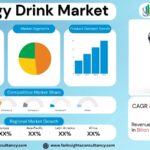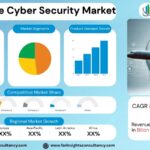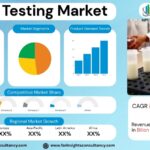
Permanent Magnet Market Trends Analysis Research Report By Type (Neodymium Iron Boron Magnet, and Other), By End-Use Industry (Automotive, Aerospace & Defense, and Other End-Use Industries) & Region (North America, Europe, APAC, MEA, South America) - Global Forecast to 2030
Aug-2024 Formats | PDF | Category: Chemical and Material | Delivery: 24 to 72 Hours
Permanent Magnet Market is expected to
grow rapidly at 6.8% CAGR consequently, it will grow from its existing size of
from $33.8 Billion in 2023 to $54.6 Billion by 2030.
Permanent Magnet Market A Comprehensive Overview and Future Developments
The permanent magnet market is going through strong
worldwide growth, which is mainly the result of the megatrends of
electrification and energy efficiency. With a market valued in the tens of
billions of dollars, the forecast is for the next 10 years to see a stable high
Compound Annual Growth Rate (CAGR) with the main segments being NdFeB, Ferrite,
and SmCo.
N dFeB magnets are the strongest and smallest ones
which have the highest market share and are used as the basic parts in modern
electronic and mobility applications. This market boom is largely attributed to
the worldwide shift towards decarbonization and smart technology, which is
leading to the use of permanent magnets for high performance and
miniaturization in all kinds of application areas.
Permanent magnet industry is largely propelled by
the most recent electoral decisions. The electric car technology (EV) is
embraced at a high speed and the clean energy sector is booming. Thus permanent
magnets are very important in the motors of EVs and HEVs, as they ensure high
efficiency, low weight, and the possibility of small sizes of vehicle parts. In
a similar way, a rapid increase in wind energy plants is especially beneficial
for direct-drive wind turbines where large quantities of high-performance
rare-earth magnets are needed for low-losses energy generation. Moreover, the
continuous desire for smaller and more powerful gadgets, the likes of which
are smartphones,
laptops, and wearables, as well as industrial automation and robotics
developments, keep the demand for high-specification magnets very strong.
Permanent Magnet Market Dynamics
Trends
The permanent magnet market in 2025 is mainly
recognized by vibrant demand, which is overall supported by the whole world’s
move towards electrification and renewable energy, although the upward trend is
somewhat restricted by the instability of the supply chain. One of the most
important driving forces is a steep increase in demand for the electric vehicle
(EV) sector, where high-performance Neodymium Iron Boron (NdFeB) magnets are nothing
but the right solution for Permanent Magnet Synchronous Motors (PMSMs) due to
their best efficiency and small size. This is in line with a similar surge from
the renewable energy sector, particularly in direct-drive wind turbines that
rely on powerful magnets for optimal energy generation.
On top of that, the ongoing trend of
miniaturization in consumer electronics (like smartphones and wearables) and
the fast growth of industrial automation and robotics likewise are major
factors behind the necessity of permanent magnets made of high-strength and of
small size. Geographically, the Asia-Pacific area is still leading the race
being supported by its large industrial base and control of the entire rare
earth element supply chain.
On the other hand, among the issues raising
challenges and shaping trends in this sphere is, first of all, the unstable
geopolitical situation, and the rarity and price volatility of raw materials
for the production of rare earth metals, such as neodymium, dysprosium and
terbium, which are largely under the control of China. This is resulting in
doubling the speed of the development of two opposite movements: a
diversification of supply chains away from China, including new domestic
production capabilities in North America and Europe, and a substantial amount
of research and development into alternatives, such as rare earth-free or
reduced-rare earth magnets, and advanced recycling technologies to improve the
environment and the security of materials.
Growth
Drivers
The permanent magnet market growth in 2025 is
primarily fueled by the global energy transition and the increasing need for
energy efficiency among various high-tech industries. The electrification of
the automotive sector is undoubtedly the most significant driver, as the global
demand for Electric Vehicles (EVs) and Hybrid Electric Vehicles (HEVs) is
skyrocketing. Besides, Permanent Magnet Synchronous Motors (PMSMs), which are
made of high-quality Neodymium Iron Boron (NdFeB) magnets, are the basic
technological choice for EV powertrains due to their high energy efficiency,
high power density, and the ability to make vehicles lighter, directly leading
to the use of more magnets.
The next fundamental driver is the clean energy
industry, particularly wind energy, which is undergoing a significant
expansion. The need for high quantities of high-quality permanent magnets to
make large-scale direct-drive wind turbines operate efficiently is going to be
met by new installations and the increasing capacity of offshore projects, thus
being the main factors for market growth.
Also, the miniaturization and the performance
enhancement of consumer electronics are the continuous trends, which are potent
growth factors, as smaller and more powerful magnets are necessary for
components in smartphones, tablets, smart home devices, and wearables. The
above-mentioned factors are further reinforced by the rapid adoption of
industrial automation, robotics, and drones, which are the main sources of
demand increase, as these applications are dependent on compact,
energy-efficient permanent magnet motors for precise motion control, which, in
turn, are the reasons for the market to have a robust break-out in 2025.
Restraints
In 2025, the permanent magnet market is inundated
with several challenges that are the main reasons for these market restrains.
These challenges are primarily related to the extreme concentration of the
supply chain and the potential risk of geopolitics associated with rare earth
elements (REEs) that are the building blocks of powerful high-performance
Neodymium Iron Boron (NdFeB) magnet. At the moment, China is the leader of the
global supply chain that means, it holds almost the total number of rare earth
refining and magnet manufacturing capacities.
Dependence on China ‘s export has a double-edged
effect on the permanent magnet market, which has been deepened by latest
incidents, such as the export restrictions and the new licensing requirements
imposed by China on the key rare earth elements only, e.g., dysprosium and
terbium, resulting in short supply shocks and price instability for the
manufacturers situated in countries other than China.
Moreover, one of the factors that restrain the
market is the unsteady and often exorbitant raw material prices. The prices of
REEs fluctuate widely and the production cost of magnet manufacturers also
changes accordingly with the financial planning making so uncertain which can
result in either a decrease in the profit margin or an increase in the prices
of end-user industries like automotive and wind energy. Exacerbating the
problem of mining and processing is progressing environmental issues. The
activity to extract these materials is not only chemically complex but also
energy-intensive, thus, it is under rigorous environmental supervision, which
causes the slower development of new, diversified mining and refining projects
in the area far from the dominating region. Finally, despite the efforts of
scientists to find substitutes for rare earth materials in the future, the lack
of proven, cost-competitive alternatives to high-performance NdFeB for use in
EV motor still limits the market flexibility.
Opportunities
In 2025, the market of permanent magnet looks to be
filled with a lot of opportunities and is mainly influenced by the transition
to clean energy and the development of high technology sectors. The foremost
and most impactful opportunity is the worldwide rapid implementation of EVs,
which in their turn, depend on high-performance permanent magnet synchronous
motors (PMSMs) for their remarkable efficiency and power density. Besides, the
huge growth of sustainable energy installations is pushing demand even higher,
especially the building of big direct-drive permanent magnet generators for
both onshore and offshore wind turbines that need large quantities of Neodymium
Iron Boron (NdFeB) magnets.
Moreover, in addition to the two major sectors, the
forecast predicts a considerable increase in the demand for new applications
that are industrial automation, the use of robots in various fields and medical
technologies, such as advanced surgical robotics and high-precision diagnostic
equipment, all of which require compact, powerful, and reliable magnetic
components. The trend of supply chain lessening dependency on a single source
and localization is a gigantic opportunity in front of producers who are not
from China. Geopolitical conflicts have driven Western governments and
companies to allocate massive capital to the building of new domestic rare
earth mining, purifying, and magnet manufacturing facilities, thus giving a
premium market for resilient, localized supply.
Challenges
The biggest challenge to the permanent magnet
market in 2025 is the Chinese-centric geopolitical and supply chain
concentration that is so extraordinary. China is the one who mines, processes,
and manufactures the most advanced technology-based magnets, which are the
first and most necessary materials in the whole permanent magnet industry. The
dominance creates a risk so severe that it is a single-point-of-failure risk,
which is further sent against recently China has implemented new and strict
export licensing regimes for key magnet-forming elements such as dysprosium,
terbium, and the like, producing longer lead times and more supply uncertainty
for manufacturers located in regions other than Asia.
This dependence on China is made worse by the wild
changes in raw material prices where market uncertainty concerning quotas and
trade conflicts, for example, the threat of high tariffs from the US causes the
prices of rare earth oxides to go up and down unexpectedly and abruptly in a
way that makes the industries that are at the downline of electric vehicles and
wind power have a hard time doing long-term planning and stable pricing.
Additionally, the industry is facing some environmental and sustainability
challenges which have to do with radioactive waste generation from mining and
chemical-intensive separation processes for rare earth elements, and that the
energy and water consumed are huge, and this causes even more ESG scrutiny and
thus slowing down the approval of new mining projects in the whole world.
Competitive
Landscape of the Permanent Magnet Market
The permanent magnet market is a critical component
of modern technology, powering everything from electric vehicles to renewable
energy systems.
· TDK Corporation
· Shin-Etsu Chemical Co. Ltd.
· Electron Energy Corp.
· Goudsmit Magnetics Group
· Hangzhou Permanent Magnet Group
· Thomas & Skinner Inc.
· Pacific Metals Co. Ltd.
· Eclipse Magnetics Ltd.
· Arnold Magnetic
Technologies
Permanent
Magnet Market Company News
Arnold Magnetic Technologies
Corporation:
Announced the expansion of its new facility in
Amata City, Chonburi, Thailand in October 2024 to better serve customers across
Asia Pacific, Europe, and the U.S.
Proterial, Ltd. (formerly Hitachi
Metals), Shin-Etsu Chemical Co., Ltd., and TDK Corporation (Japan):
These are consistently cited as key global players.
TDK is a specialist in ferrite and rare-earth magnets for automotive, energy,
and consumer electronics applications.
E-VAC Magnetics:
Plans to open a sintered NdFeB magnet plant in
Sumter, South Carolina, in late fall 2025, with a significant grant from the US
Department of Defense.
Noveon Magnetics (USA):
A rising US-based manufacturer producing NdFeB
magnets and planning a significant expansion from 2,000 tonnes per year to
10,000 tonnes per year to challenge Chinese dominance.
Permanent
Magnet Market Segment Analysis
The permanent magnet market is shaped by magnet
type, application, and geographic region.
By Type
- Neodymium Iron Boron Magnet
- Ferrite Magnet
- Samarium Cobalt Magnet
- Aluminum Nickel Cobalt Magnet
By End-Use Industry
- Automotive
- Consumer Electronics
- Aerospace & Defense
- Energy
- Medical
- Other End-Use Industries
Permanent
Magnet Market Regional Outlook
The global permanent magnet market is influenced by
regional industrial dynamics, technological advancements, and environmental
considerations.
North
America
The U.S. federal government, especially the
Department of Defense (DoD), is pouring a lot of money into a vertically
integrated homegrown rare earth magnet supply chain.
MP Materials: The DoD and MP Materials have signed
a historic public-private partnership deal that intends to massively increase
the manufacturing capacity of rare-earth magnets in the United States.
Canada: One of the most important areas in the
Canadian Critical Minerals Strategy is the development of permanent magnets.
The country is now seeking to broaden its sources of permanent magnets as China
has a significant hold on the entire metal-to-magnet value chain globally.
Europe
The permanent magnet market in Europe is
experiencing significant growth, primarily driven by its ambitious green energy
transition and the rapid electrification of its transport sector.
Germany
Europe’s most influential market. It accounts for
the highest proportion of regional consumption, led by its huge automotive (EV
production) and industrial machinery/automation sectors. The magnet industry in
this region is supported by two of the leading European companies, namely
Va-Schu and MS, which are deeply involved in the production of high-grade
sintered magnets and at the technological forefront. Anticipated to have the
highest CAGR.
France & Italy
France is a major consumer of magnets, mainly for
the local automotive and industrial machinery sectors. The country is also
significantly active in the aerospace and defense industry, which is a major
user of highly specialized and frequently heat-resistant magnets, such as
samarium cobalt (SmCo).
UK
It’s one of the most important places where new
researches are done and where the most specialized magnets are used, with a
concentration on advanced engineering, aerospace, and small industrial systems.
There are a lot of magnet distributors and systems integrators in the area.
Eastern Europe (e.g., Estonia)
One of such examples is Neo Performance Materials
which is setting up its initial significant site for the manufacturing of rare
earth magnets in Narva, Estonia, so as to be able to supply the entire European
EV and wind industries locally with a stable and reliable supply chain.
Asia-Pacific
The Asia-Pacific region accounts for most of the
global permanent magnet market and is both the core manufacturing and
consumption center owing to the region’s thorough control over the rare earth
element (REE) supply chain and its colossal electronics and automotive
production bases. The region is forecasted to keep its leading market share and
demonstrate the highest Compound Annual Growth Rate (CAGR) worldwide up to
2030, mainly because of the huge demand for Neodymium-Iron-Boron (NdFeB)
magnets that are the best choice for electric vehicle (EV) traction motors and
direct-drive wind turbine generators.
By far, China comes in as the center of the market
with almost the whole rare earth mining, processing, and permanent magnet
production capacity kept by it. The domestic demand of it is enormous, driven
by government-backed megatrends including the massive build-out of EV
manufacturing (e.g., BYD), soaring industrial robotics production, and being
the world leader in new wind power installations. With this vertical
integration from rare earth oxides to finished high-performance magnets, China
is not only in a position to determine the world price and supply dynamics but
is also under internal requirements to enhance energy efficiency and decrease
the content of heavy rare earth in magnets.
Japan and South Korea: These countries are the ones
that represent the high-value, high-technology, Asia-Pacific region market
where they focus on advanced magnet applications and high-quality standards.
Japan, the home of major magnet manufacturers such as Proterial (formerly
Hitachi Metals) and TDK Corporation, is very good at producing premium,
high-coercivity sintered NdFeB magnets for sophisticated automotive and
precision electronics. In the same way, South Korea’s strong automotive
industry (e.g., Hyundai and Kia) and consumer electronics sector generate great
demand for both sintered and bonded NdFeB magnets.
Rest of Asia-Pacific (including India and Southeast
Asia): The wider Asia-Pacific market is distinguished by fast-growing
manufacturing and urbanization, leading to rising demand. The Indian renewable
energy and automotive industries, especially the wind energy part, are developing
into permanent magnet sectors that will be the future markets in this category.
The countries in Southeast Asia heavily contribute to it through their global
consumer electronics assembly and industrial automation supply chains, which
need different types of magnets for motors, sensors, and actuators, making the
region as a whole the biggest permanent magnet industry market.
Latin
America and the Middle East
The permanent magnet market in the Middle East is
experiencing substantial growth, basically, this is due to the large economic
diversification programs that mainly focus on green energy and industrial
modernization themes. The Gulf Cooperation Council (GCC) subregion embracing
Saudi Arabia and the United Arab Emirates (UAE) is the area being most impacted
by the development. The environmental and energy sector has become a major
contributor to the demand for the use of high-performance magnets, especially
NdFeB. The reason for that is the utility-scale solar projects and green
hydrogen facilities have been at the forefront, which highly efficient motors
and generators are required for. In addition to that, the government is
promoting the use of electric vehicles (EVs), therefore the demand in the
automotive industry is increasing rapidly as well. For instance, the Dubai
Green Mobility Strategy is the main factor of electric vehicle usage in the
UAE. Permanent magnets are used to improve the quality of smart city and
high-tech industrial machinery projects in Saudi Arabia as well as the UAE,
Eastern Asian markets are setting the trend for their regional trajectories to
be strong.
The permanent magnet market in Latin America is
steadily headed to an upward curve, with regional industrialization,
infrastructural development, and the drive for a cleaner energy mix being the
main sources of energy. This market is mainly driven by subregions such as
Brazil and Mexico. Brazil holds the majority of the market share. The demand is
largely generated by the vibrant automotive manufacturing sector and the country’s
wind energy capacity growth, where permanent magnets used in direct-drive
generators have been the main components. Market growth in Mexico is
increasingly dependent on global supply chains. This is because it has
positioned itself as the major manufacturing and export hub for the automotive
industry, including the production of electric and hybrid vehicles. Moreover,
these countries are also contributing through increased deployment of
industrial automation, energy-efficient appliances, and new infrastructure
projects. The Latin American market is thus positioned for continuing
moderate-to-high growth overall.
Frequently
Asked Questions:
What is the current size of the
Permanent Magnet market?
Permanent Magnet Market is expected to grow rapidly
at 6.8% CAGR consequently, it will grow from its existing size of from $33.8
Billion in 2023 to $54.6 Billion by 2030.
List the segments encompassed in this
report on the Permanent Magnets Market?
Market.US has segmented the Permanent Magnets
Market Market by geographic (North America, Europe, APAC, South America, and
MEA). By Type, market has been segmented into Neodymium Iron Boron Magnet,
Ferrite Magnet, Samarium Cobalt Magnet, Aluminum Nickel Cobalt Magnet. By
End-Use Industry, the market has been further divided into Automotive, Consumer
Electronics, Aerospace & Defense and other.
Which segment dominate the Permanent
Magnets industry?
With respect to the Permanent Magnets industry,
vendors can expect to leverage greater prospective business opportunities through
the Ferrite Magnet segment, as this dominate this industry.
Name the major industry players in the
Permanent Magnets Market.
Proterial Ltd., TDK Corporation, Shin-Etsu Chemical
Co. Ltd., Electron Energy Corp., Goudsmit Magnetics Group and Other Key Players
are the main vendors in this market.
Key
Benefits to Stakeholders:
· This study offers a quantitative examination of
Permanent Magnet Market trends, estimations, and dynamics from 2024-2030 to
identify potential opportunities in this space.
· Porter’s five forces study emphasizes the value
of buyers and suppliers in helping stakeholders to make profitable business
decisions while expanding their network.
· Undergoing in-depth analyses on market size and
segmentation is vital in identifying current Permanent Magnet Market
opportunities.
· Each region’s largest countries are mapped
according to their revenue contribution for an accurate picture of this global
industry.
· The Permanent Magnet Market research report
offers a thorough examination of its major players. As such, purchasing this
report provides many advantages to any organization looking to enter this
competitive industry.
Reasons
to Purchase Permanent Magnet Market Report:
· Current and Future Prospects of Permanent Magnet
Market in both developed and emerging markets.
· Porter’s Five Force Analysis to help analyze
various perspectives within this market. Major regions should experience rapid
increases during this time.
· Uncover the most up-to-date industry
developments, Permanent Magnet Market shares, and top market players’
strategies.
Customized
Report as per your Business Needs
· Our analysts will work directly with you and
understand your needs
· Get data on specified regions or segments,
competitor and Vendors
· Data will be formatted and presented as per
your requirements
Any Requirement Contact Us: Https://Www.Forinsightsconsultancy.Com/Contact-Us/
Table of Contents
- Table 1: Global Permanent Magnet Market Revenue by Type, 2024-2030
- Description: Breakdown of market revenue by type of permanent magnet (e.g., neodymium-iron-boron (NdFeB), samarium-cobalt (SmCo), alnico, ceramic/ferrite).
- Table 2: Regional Market Share of Permanent Magnets, 2024-2030
- Description: Market share distribution by region (North America, Europe, Asia-Pacific, Latin America, Middle East & Africa).
- Table 3: Market Growth Rate of Permanent Magnets by Region, 2024-2030
- Description: Compound Annual Growth Rate (CAGR) of the permanent magnet market segmented by region.
- Table 4: Key Market Players and Their Market Share in Permanent Magnets, 2024
- Description: List of major companies in the permanent magnet industry and their respective market share.
- Table 5: Trends and Innovations in Permanent Magnet Technologies, 2024-2030
- Description: Summary of key trends, technological advancements, and innovations in permanent magnet technologies.
- Table 6: End-Use Industry Analysis for Permanent Magnets, 2024-2030
- Description: Market segmentation by end-use industry (e.g., automotive, electronics, energy, industrial machinery, consumer goods).
- Table 7: Comparison of Permanent Magnet Types, 2024-2030
- Description: Comparative analysis of different types of permanent magnets based on performance, cost, and applications.
- Table 8: Regional Demand for Permanent Magnets, 2024-2030
- Description: Regional breakdown of demand for permanent magnets.
- Table 9: Price Trends for Permanent Magnets, 2024-2030
- Description: Historical and projected price trends for various types of permanent magnets.
- Table 10: Regulatory and Environmental Factors Affecting Permanent Magnets, 2024-2030
- Description: Overview of regulations, environmental considerations, and compliance issues impacting the permanent magnet market.
- Table 11: Market Adoption Rates of Permanent Magnets by Application, 2024-2030
- Description: Adoption rates and market penetration of permanent magnets in different applications.
- Table 12: Cost-Benefit Analysis of Permanent Magnets by Type, 2024-2030
- Description: Analysis of costs versus benefits for different types of permanent magnets.
- Table 13: Performance Metrics of Permanent Magnets, 2024-2030
- Description: Key performance metrics such as magnetic strength, temperature stability, and coercivity for various permanent magnets.
- Table 14: Major Permanent Magnet Projects and Case Studies, 2024-2030
- Description: Notable projects and case studies demonstrating the application and impact of permanent magnets.
- Table 15: Forecast of Permanent Magnet Market by Magnet Type, 2024-2030
- Description: Market forecast and projections for different types of permanent magnets.
Select PDF License
Single User: $3499
Multiple Users: $4499
Corporate Users: $5499







[…] purposes of this analysis are: To characterize, portray, and check the Global Permanent Magnet Market based on product type, application, and region. To estimate and inspect the size of the […]